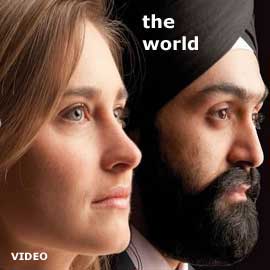Columnists
Seeking Peace:
Hemkund and the Valley of Flowers
MICHAEL BENANAV
Deep in the gorge that it carves through the Himalayas, the Alaknanda River rushed beneath a footbridge. On the right bank sat a busy village, Gobindghat, its one street lined with spartan hotels and shops brimming with Sikh religious items and souvenirs.
On the left bank, a
man wearing a frayed sweater-vest and a ski cap greeted me imploringly.
“Horse?” he asked, hoping I would hire his mules to haul me and my pack up the path to Ghangaria, an isolated mountain hamlet in Uttarakhand state. Ghangaria is the base for visiting the legendary Valley of Flowers National Park -- where some 300 varieties bloom in peak season -- and Hemkund, a lake and sacred Sikh pilgrimage site in the Garhwal Himalayas.
“Horse?” he repeated. “Five hundred rupees...”
I thought about it. Ghangaria can be reached only by foot, hoof or helicopter (the latter being way beyond my budget). The route is about eight miles long and climbs some 4,000 feet, to 10,006 feet above sea level. It was already afternoon and I’d eaten only a few biscuits that morning. But it was a brilliantly sunny day and I felt energetic. Even as the price dropped to 400 rupees -- less than $8 -- I declined and headed up the first set of switchbacks, knowing I could eat Maggi masala (local ramen noodles) at a trailside stand and hire a “horse” along the way if I changed my mind. (Eventually, I did).
The cobblestone trail rose through a valley flanked by steep, forested slopes, capped by bare cliffs. Below, the Lakshman Ganga -- a tributary of the Alaknanda -- surged with startling force, as glacial snowmelt poured down over huge boulders.
Between early June and early October -- except when landslides triggered by monsoon storms block the mountain roads -- hundreds of Sikh pilgrims tackle the trail each day. When I was there in late September, it flowed with people eager to worship at one of the holiest places to visit in the Sikh religion.
Many traveled as families, most of them headed by bearded men in colorful turbans. Some wore traditional kurtas or blue warrior robes, others wore jeans and sweatshirts. The most devout walked barefoot. Some who couldn’t manage the climb rode mules. Others sat on wooden litters carried on the shoulders of four men, or in wicker chairs hauled like backpacks by porters.
The latter two options, I thought, surely belonged on a list of “stuff in India that you’d never see in the United States.”
Shortly before dusk I reached Ghangaria, where it was so cold I was soon wearing every piece of warm clothing I had with me. My hotel room, like all others in town, had no heat; hot water was available only in buckets, for a small fee. On the plus side, the bed was piled with blankets, and prices were negotiable (I paid 300 rupees, about $5.50 at 55 rupees to the dollar.)
By the time I set out for Hemkund the next morning many pilgrims were already on the trail. We’d have to climb another 4,000 feet in just four miles to reach the hallowed lake, which sits 14,200 feet above sea level. The place had to be special, really special, to inspire all of these people -- most of whom wouldn’t be described as “outdoorsy” -- to undertake this kind of trek. There was clearly something at stake here beyond sightseeing, which I reflected on as I hiked.
Pilgrimages, religious or otherwise, are inspired by stories -- some true, some fictional and some in which fact and legend are seamlessly stitched together. Regardless of their veracity, these stories resonate. The places where the stories are set become salient landmarks in the geographies of our imaginations. They seem to call to us from within, urging us to go to them and promising to complete us in some way if we do. Think of Jerusalem or Mecca, ground zero or even Graceland; these are not mere dots on a map, but places loaded with meaning that draw travelers to them.
And when we go -- when we reach these places that through their stories have reached into us -- it’s as though our inner world unites with the outer. At least for a little while.
The story behind Hemkund relates to the 10th and last Sikh Teacher, Guru Gobind Singh, who lived from 1666 to 1708. One of the religion’s most influential founding fathers, he introduced many of the practices that define the faith to this day. Gobind Singh wrote that in a previous life he had meditated at a mountain lake ringed by seven peaks; there, he had become one with God, physically as well as spiritually, before being reborn as Gobind.
For centuries, the location of Hemkund remained a mystery, until it was rediscovered in 1934 by a retired army officer named Sohan Singh. It turned out to be a lake called Lokpal, which had long been considered holy by the locals, but who were not Sikh.
These days, it’s estimated that upward of 150,000 people make it there each year.
Though I’d gone on personal pilgrimages before -- to the village in Ukraine where my grandmother lived in a ghetto during World War II, and where much of her family perished; to the surreal desertscape of Wadi Rum, in Jordan, where T. E. Lawrence, my childhood hero, once roamed -- I didn’t think of my trek to Hemkund in those terms.
Here I was a tourist, not a pilgrim. But even to a nonbeliever, the allure of a sacred lake high in the Himalayas was irresistible. And as someone with an abiding interest in the world’s religions, I hoped to get some insight into what it meant to the Sikh faithful to reach their holy place, especially after what had to be endured to get there.
After hiking out of Ghangaria and following the serpentine trail up a mountain for two and a half hours, I reached the little lake surrounded by rocky peaks. People were immersing themselves in the freezing waters, eating daal (lentil soup) made by volunteer cooks at the langar, or communal kitchen, and resting. The mesmerizing rhythms of Sikh kirtan, or hymns, spilled from a gurdwara whose multi-angular pitched metal roof made it easy to mistake for a spaceship.
Inside, worshipers sat on a red carpet facing a golden canopy, beneath which a granthi waved a feathered whisk over a copy of the holy Sikh scriptures. In front of him, a table was decorated with plastic flowers, 11 plush-toy tigers and one leopard. The pilgrims were exceedingly friendly, and many spoke English. They seemed pleased to see a foreigner and were happy to talk about their experiences.
“It’s inspirational,” said Sukhmeet Singh, who is Indian-born but now lives in Australia. He was traveling with his parents, his wife and two children. For him, the journey seemed as important as the destination; he compared it favorably to the Tony Robbins seminars he’d attended, saying that meeting the challenge of the trek made him feel as if he could accomplish anything.
Others echoed what he had said. One man told me that sick people dipped in the lake to “cure-ify” their illnesses. But most of those I talked to spoke of Hemkund as a place of purification, which would take them “away from all evils” and inoculate them against future ones for some time.
In the langar, 23-year-old Aman Jot Singh, from Punjab, sat behind a pot big enough to bathe in, serving hot chai. In his free moments, he read Sikh scriptures on his smartphone. Every day, he told me, he hiked up from Ghangaria to volunteer in the kitchen. Every night he hiked back down. All summer. To him, it was a form of austerity and penance.
“I was like what you could call a playboy, into drinks and women, and I cut my hair,” he said. “I had a big ego problem. But last year I decided I had to change, to live right. And this helps. It’s the best thing I’ve ever done in my life.”
The effects of Hemkund, he said, would fill him with a lasting peace and keep him on a righteous path long after he returned home.
In midafternoon, I descended to Ghangaria for another frigid night’s stay.
The following morning, I hiked into Valley of Flowers National Park, just a couple of miles upstream along the Pushpawati River. The trail passed through a narrow canyon, which opened up into a landscape so sublime -- and so different from the Ghangaria side of the slot -- that I felt like I’d been transported to another world.
The three-mile-long valley was framed by walls of snow-crowned, cloud-scraping peaks. Ribbons of water plunged thousands of feet down sheer rock faces, then flowed across rolling meadows. The greens and yellows and browns and steel grays of the earth, flecked with myriad other colors, were constantly changing hues, as sheets of cirrus filtered the sun. I scanned the slopes, hoping for a glimpse of a snow leopard, bear or musk deer, but saw none.
The peak bloom, for which the valley is renowned, had passed. In July and August, during the monsoon season, the basin floor is said to be a rainbow of flowers, the equal of any botanical extravaganza in the world. When I was there, just a smattering of blossoms remained.
But I had no regrets: coming after the monsoon meant a much better chance of sunshine and a much smaller chance of being delayed -- or worse -- by an apocalyptic cloudburst. And the valley, flowers or not, was still an alpine paradise.
Very few people were there. Walking along the trail, alone and unobserved, I could succumb to pure awe with no taint of self-consciousness.
In a way, I experienced at the Valley of Flowers what the Sikh pilgrims sought from Hemkund. Maybe not purification but peace, and a sense of contact with something far greater than myself: the Himalayas.
Might I make a pilgrimage back to the valley in the future?
Perhaps. It would be nice to see the flowers.
Hemkund is open from about June 1 to Oct. 5. Valley of Flowers National Park is open from June 1 to Oct. 31. Park admission for non-Indians is 600 rupees (about $11) for three days.
Conversation about this article
1: Aryeh Leib (Israel), June 13, 2013, 2:13 PM.
Sounds like a great trip ... but, what do pilgrimage, purification by water, etc., have to do with Sikhi?!
2: Gurpal (United Kingdom), June 13, 2013, 3:54 PM.
Aryeh ji, they may not have much to do with Sikhi, but I guess different people sometimes take different paths. Some people need pilgrimage, etc., to support their external spirituality before working on their internal spirituality, but once they gain confidence, it is imperative they move past it. As long as its a phase in the path towards Sikhi, it's the end result that matters.
3: Sandeep Singh Brar (Canada), June 13, 2013, 5:11 PM.
Lovely gurdwara in some fantastic scenery ... would love to visit there. No historic significance though, as Sikhs don't worship past lives and the location of the gurdwara was chosen arbitrarily by a Nirmala in the early 20th century. I'm not planning on visiting the temple of Durga at Jwalamukhi any time soon where Bhai Lehna used to lead Hindu pilgrimages to, before becoming a Sikh and then named Guru Angad.
4: Gurinder Singh (Stockton, California, U.S.A.), June 13, 2013, 6:34 PM.
To post # 3: Bhai Vir Singh was the spirit behind establishing this gurdawra. One thing, he was not Nirmala; and, second thing, all Nirmalas were not bad. They made great contributions to the advancement of Sikhi and Sikh literature. Many saintly Sikhs such as Baba Attar Singh ji Mastuanewale who spearheaded the resurgence of Sikhi to face the onslaught of arya samaj, was a Nirmala.
5: Raj (Canada), June 13, 2013, 11:36 PM.
I have been there and I have mixed feelings about it. First, is it that the place is holy? The answer is yes, because our current Guru -- Guru Granth Sahib -- is residing there. Second, the story about Guru Gobind Singh's previous life and tapasya done then? I'm not at the spiritual level where I can make any conclusion. Third, was it worth visiting Hemkund? The answer is yes, because I tested my physical limits at the very high altitude and had great company with me. Last, would I do it again? The answer is no, because washrooms are extremely wanting and the building of the gurdwara has not been constructed with extreme conditions in mind. It hurts to see a beautiful building heading toward dilapidated stage.
6: Gurinder Singh (Stockton, California, U.S.A.), June 14, 2013, 4:15 AM.
The present building was erected by the chief engineer of the Army corps of engineers. It is not easy to construct a building at +15K elevation.
7: Chintan Singh (San Jose, California, USA), June 14, 2013, 11:38 AM.
I have gone to Hemkunt Sahib a couple of times in my childhood and youth. Would I do it again? Yes, and that is regardless of non-beliefs re 'past lives'. The amazing experience with the sangat is there for one common goal, i.e. Sikhi and singing praises of Waheguru. These and the chance to visit other gurdwaras as part of the whole tour are good enough reasons for me to take the trip again and again, and plus you get to enjoy fresh air, beautiful greenery and scenery which are rare to find in cities. I don't quite understand the sentence: "In front of him, a table was decorated with plastic flowers, 11 plush-toy tigers and one leopard." Could someone help me with why the presence of plush toy tigers and leopard in a gurdwara?




